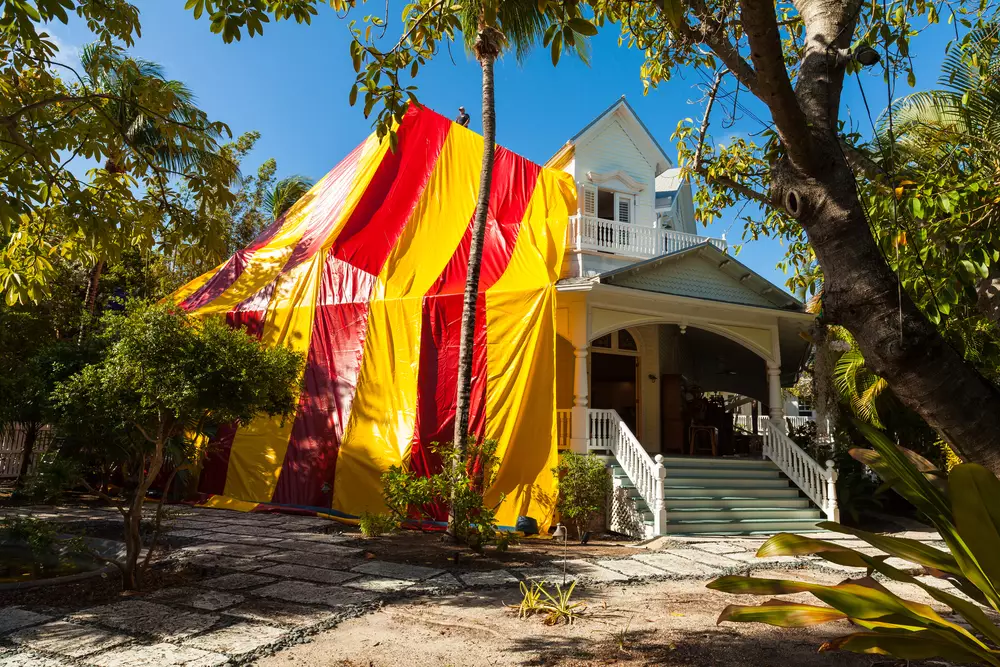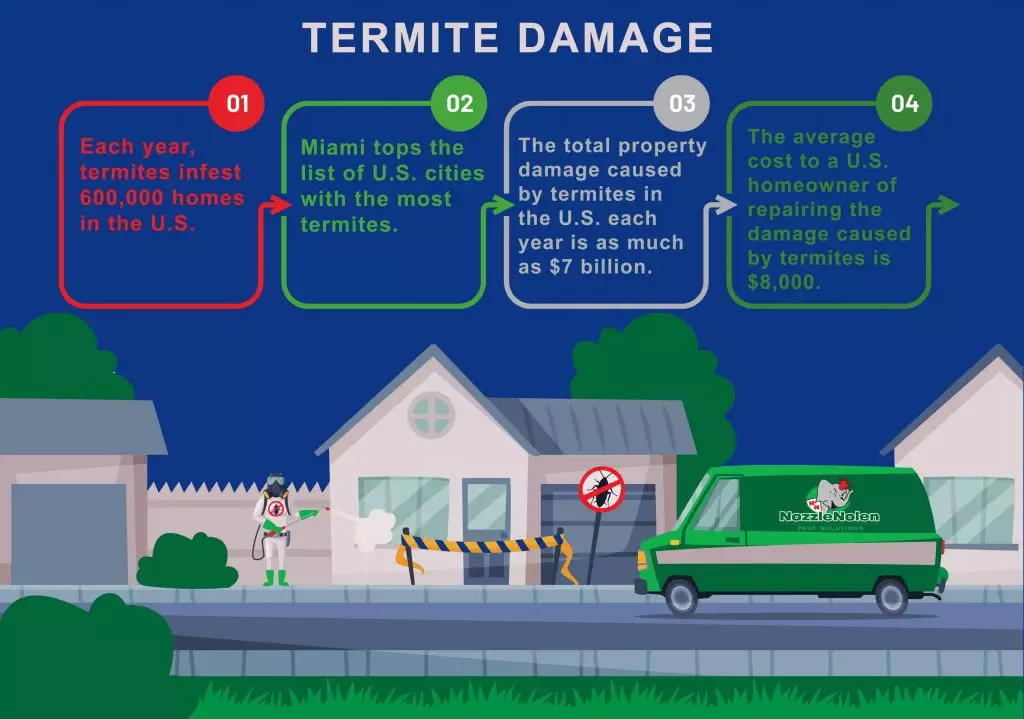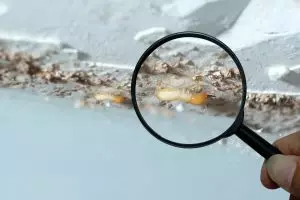
South Florida residents are well aware of the threat to their homes from hurricanes, floods, and even the occasional tornado. But there’s another very real threat to residences and businesses in the area posed by tiny, six-legged critters with voracious appetites—termites.
- Each year, termites infest 600,000 homes in the U.S.
- Miami tops the list of U.S. cities with the most termites.
- The total property damage caused by termites in the U.S. each year is as much as $7 billion.
- The average cost to a U.S. homeowner of repairing the damage caused by termites is $8,000.

It’s clear that South Florida home and business owners shouldn’t take lightly the threat posed by termites. Termites are reclusive insects and are easy to mistake for ants or other look-alike species. As the termite swarming season winds down, it’s time for property owners to search for signs of a new termite infestation:
- Look for the discarded wings of termite swarmers around exterior window frames and door frames.
- Termites are so talented at staying out of sight that your first indication of their presence may be hearing them make tapping sounds in your walls.
- When your home’s wooden structures are damaged by termites, you may find cracks in walls and ceilings, or window and door frames might become misaligned.
- Subterranean termites nest in the ground outside the structure and build mud tubes to reach the wooden parts in your home or business.
If you encounter these structure-damaging pests on your property, your primary treatment choices are fumigation or heat treatment. Each approach has its advantages for specific situations, but a growing number of property owners find heat treatments are the best option. Here’s a look at the benefits of termite heat treatments for home and business owners.
How Effective Are Termite Heat Treatments?
Just as no two termite infestations are identical, no generic termite solution will work in all situations. A trained and certified pest control technician such as those employed by Nozzle Nolen will inspect your property from top to bottom and determine the optimal treatment plan for your needs, such as:
- Conventional foundation treatments
- Tent fumigation
- Non-tent treatments
- Tape-and-seal fumigation
- Heat treatments
- Vault fumigation for valuable furniture
While many infestations can be eradicated with spot treatments, others will require that the entire structure be treated, either with heat or fumigation.
- Fumigants are effective at treating hidden termite sites in the structure, but their use must be monitored carefully to achieve the correct dosage.
- Fumigation requires that people stay out of the home or business for several days, and all gas pilot lights must be extinguished before the treatment and relit afterward.
- Heat treatments are also effective at reaching hidden termite locations, but the temperature that is lethal to termites (about 120°F) must reach the core of the infested wood. This requires that the temperature be sustained for at least 35 minutes.
- The high temperature may damage some items in the structure, so any heat-sensitive items must be removed prior to the treatment.
A primary advantage of heat treatments is that the structure needs to be vacated for only a few hours rather than several days, as fumigation requires. Termite heat treatments can also be applied to only portions of a structure, such as a single apartment in a building. One disadvantage of heat treatments is that some dense wood structures, such as those atop concrete or tile, are difficult to heat to the necessary temperature.
How Much Do Termite Heat Treatments Cost?
The cost of termite heat treatments depends on several factors, including the size and style of the house or building and the extent of the infestation. One estimate of the national average cost of termite heat treatments is $5,000 for a 2,500-square-foot home in a range from $1,000 to $12,000. Another estimate puts the price at $800 to $2,500, or about $10 per linear foot.
The heat treatment process takes about eight hours to complete and entails eight steps:
- Conduct a pre-treatment inspection to identify the type of termite (Subterranean, Drywood, etc.) and look for wood damage, swarms, mud tubes, termite droppings, or other signs of an infestation.
- Remove any household or other items that would be damaged by being exposed to high heat.
- Seal the structure in a tent to allow the internal temperature to be controlled.
- Put the heat sensors and large hoses for the hot air in place.
- Blow hot air into the tent until the inside temperature gets to between 130-150°F
- Continue until the structure’s internal wood temperature reaches 120°F for at least 35 minutes. This is a sufficient temperature to eliminate the termites.
- Once the temperature has been maintained for a sufficient length of time, the structure is unsealed and the probes and hoses removed.
- Remove the tent and allow the structure’s temperature to return to normal levels.
After the treatment is completed, the home or business is inspected again to ensure that the entire termite colony has been eliminated. In some cases, the inspection may indicate the need for further treatment.
How Does Termite Heat Treatment Differ from Fumigation?
One benefit of termite heat treatments over fumigation is the short time required to allow inhabitants to return to the home or business. When a structure is fumigated, it is uninhabitable for three days.
These are among the other ways that heat treatment and fumigation for termite removal differ:
- Fumigation uses chemicals that can be harmful to people, pets, and plants.
- Fumigation may leave chemical residues, including fluoride.
- By contrast, heat treatments run the risk of damaging furniture and other items that weren’t removed beforehand.
Tenting for fumigation must be tight enough to prevent the sulfuryl fluoride that’s used as the active agent to escape into the environment. The Sierra Club states that the air inside the fumigated structure must be below 1 part per million before allowing people or pets back inside.
Giving Termites the Boot the Eco-Friendly Way
The best way to quell your fears of termites invading your home or business is by contacting the pros at Nozzle Nolen and ask about termite heat treatments and other ways to keep pests at bay. In addition to termite heat treatments, the company provides tent fumigation, non-tent treatments, tape-and-seal fumigation, conventional foundation treatments, and vault fumigation for valuable furniture.
Getting Started With Nozzle Nolen
Nozzle Nolen’s certified technicians take care of all the prep work and post-treatment cleanup. With Nozzle Nolen’s 365 Complete Home Protection Plan, your residence is protected year-round from termites, mosquitoes, ants, cockroaches, bees and wasps, rodents, and other pests. The program’s quarterly treatments and fast response to any recurring pest problems give homeowners peace of mind no matter the season.
Nozzle Nolen has provided expert pest control services to the residents of South Florida for more than 70 years. If you are facing an active termite infestation in your home or business and would like more information on termite heat treatment, Call us at 800.226.6536 or Contact Us. We look forward to serving you.

